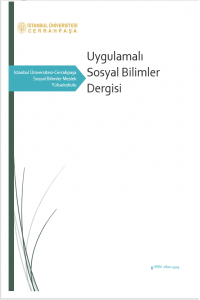ULUSLARARASI SERMAYE HAREKETLİLİĞİ ALTINDA POLİTİKA KARIŞIMLARI VE PARTİZAN IRAKSAMALAR
ÖZET
Anahtar Kelimeler:
Uluslararası sermaye hareketliliği, politika karışımları, hükümet partizanlığı, politika ıraksaması
___
- Bearce, David H . (2002), "Monetary Divergence: Domestic Political Institutions and the Policy Autonomy-Exchange Rate Stability Trade-off, Comparative Political Studies, Vol. 35, No. 2, pp. 194ı 220.
- Bearce, David H. (2007), Monetary Divergence: Domestic Policy Autonomy in the Post-Bretton Woods Era, The University of Michigan Press.
- Broz, J. Lawrence and Jeffry A. Frieden (2001), "The Political Economy O f International Monetary Relations", Annual Review of Political Science, No. 4, pp. 317-343.
- Cusack, Thomas R. (1997), "Partisan Politics and Public Finance: Changes in Public Spending i n the Industrialized Democracies, 1955-1989", Public 3, pp. 792-827. Choice, Vol. 91, Issue 3-4, pp. 375-95.
- Drezner, Daniel W. (2001), "Globalization and Policy Convergence", International Studies Review, Vol. 3, No. 1, pp. 53-78.
- Fleming, Marcus (1962), "Domestic Financial Policies under Fixed and under Floating Exchange Rates", IMF Staff Papers, Vol. 9, No. 3, pp. 369-80.
- Frieden, Jeffry A. (1991), "Invested Interests: The Politics of National Economic Policies i n a World of Global Finance", International Organization, Economy", American Journal of Political Science, Vol. Volume 45, Issue 4, pp. 425-51. 43, No. 4, pp. 1003-1027.
- Garrett, Geoffrey (1995), "Capital Mobility, Trade, and the Domestic Politics of Economic Policy", International Organization, Vol. 49, No. 4, pp. 657ı 87.
- Garrett, Geoffrey (1998), "Global Markets and National Politics: Collision Course or Virtuous Circle?", International Organization, 52: 4, pp. 787ı 824.
- Garrett, Geoffrey (2000), "Capital mobility, Exchange rates and fiscal policy i n the global economy", Review of International Political Economy, 7:1, pp. 153-170.
- Garrett, Geoffrey and Peter Lange (1991), "Political Responses to Interdependence: What's "Left" for the Left?", International Organization, Vol. 45, No. 4, pp. 539-564.
- Gowa, Joanne (1988), "Public Goods and Political Institutions: Trade and Monetary Policy Processes in the United States", International Organization, Volume 42, No. 1, pp. 15-32.
- Hallerberg, Mark (2002), "Veto Players and the Choice of Monetary Institutions", International Organization, 56: 4, pp. 775-802.
- Hibbs, Jr., Douglas A. (1977), "Political Parties and Macroeconomic Policy", The American Political Science Review, Vol. 71, No.4, pp. 1467-1487.
- Iversen, Torben and David Soskice (1999), "Monetary Integration, Partisanship, and
- Lange, Peter and Geoffrey Garrett (1985), "The Politics of Growth: Strategic Interaction and Economic Performance i n the Advanced Industrial Democracies, 1974-1980", The Journal of Politics, Volume 47, Issue
- Moses, Jonathon W. (1994), "Abdication from National Policy Autonomy: What's Left to Leave", Politics and Society, Volume 22, Issue 2, pp. 125-48.
- Mundell, Robert A. (1963), "Capital Mobility and Stabilization Policy under Fixed and Flexible Exchange Rates", Canadian Journal of Economics and Political Science, Vol. 29, No. 4, pp. 475-85.
- Oatley, Thomas (1999), "How Constraining is Capital Mobility? The Partisan Hypothesis i n an Open
- Reinhart, Carmen M . , and Kenneth S. Rogoff (2004), "The Modern History of Exchange Rate Arrangements: A Reinterpretation", Quarterly Journal of Economics, Vol. 119 (1), pp. 1—48.
- Rose, Andrew K. (1994), "Exchange Rate Volatility, Monetary Policy, and Capital Mobility: Empirical Evidence on the Holy Trinity", NBER Working Paper Series, No: 4630.
- Tinbergen, Jan (1952), On the Theory of Economic Policy, North-Holland Pub. Co., Amsterdam.
- Webb, Michael C. (1991), "International Economic Structures, Government Interests, and International Coordination of Macroeconomic Adjustment Policies", International Organization, Vol. 45, No. 3, pp. 309-342.
- Başlangıç: 2007
- Yayıncı: İstanbul Üniversitesi-Cerrahpaşa
Sayıdaki Diğer Makaleler
ŞEHİRİÇİ OTOBÜS YOLCULUKLARINDA CEP TELEFONU KULLANMA YASAKLARI ARAŞTIRMASI
OTOMOTİV SEKTÖRÜ VE GÜMRÜK BİRLİĞİ SONRASI GELİŞMELERİ
DÜNYADA VE TÜRKİYE'DEKİ TURİZM İŞLETMELERİNDE ÇEVRE KORUMAYA YÖNELİK UYGULAMALAR: AMACI VE ÖNEMİ
THEORETICAL AND EMPIRICAL SURVAY OF CONTAGIOUS FINANCIAL CRISES
THE ROLE OF INOVATION POLICIES IN SOUTH ASIAN INDUSTRIALIZATION: THE CASE OF KOREA
KANUN ADAMININ “DEHŞETENGIZ” EMEKLILIK SAATI
PAKET TUR SÖZLEŞMESİNDE TARAFLAR VE TARAFLARIN BORÇLARI VE HAKLARI
Gökçen Bilge ÖZDEMİR, Gökçen bilge Özdemir
ULUSLARARASI SERMAYE HAREKETLİLİĞİ ALTINDA POLİTİKA KARIŞIMLARI VE PARTİZAN IRAKSAMALAR
